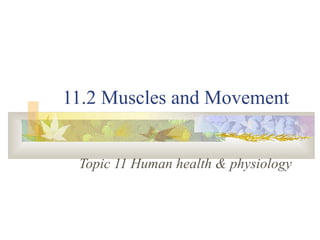
11.2 muscles and movement
- 1. 11.2 Muscles and Movement Topic 11 Human health & physiology
- 2. 11.2.1 State the roles of bones, ligaments, muscles, tendons and nerves in human movement. 11.2.2 Label a diagram of the human elbow joint, including cartilage, synovial fluid, joint capsule, named bones and antagonistic muscles (biceps and triceps). 11.2.3 Outline the functions of the structures in the human elbow joint named in 11.2.2. 11.2.4 Compare the movements of the hip joint and the knee joint.
- 3. 11.2.5 Describe the structure of striated muscle fibres, including the myofibrils with light and dark bands, mitochondria, the sarcoplasmic reticulum, nuclei and the sarcolemma. 11.2.6 Draw and label a diagram to show the structure of a sarcomere, including Z lines, actin filaments, myosin filaments with heads, and the resultant light and dark bands. No other terms for parts of the sarcomere are expected.
- 4. 11.2.7 Explain how skeletal muscle contracts, including the release of calcium ions from the sarcoplasmic reticulum, the formation of cross-bridges, the sliding of actin and myosin filaments, and the use of ATP to break cross-bridges and re- set myosin heads. Details of the roles of troponin and tropomyosin are not expected. Aim 7: Data logging could be carried out using a grip sensor to study muscle fatigue and muscle strength. 11.2.8 Analyse electron micrographs to find the state of contraction of muscle fibres. Muscle fibres can be fully relaxed, slightly contracted, moderately contracted and fully contracted.
- 5. Locomotion Most animals can move from one place to another. This is called Locomotion. Animals show a wide variety of types of locomotion. Locomotion is produced by the combined effect of three parts of the body: Nerves Muscles Bones
- 6. Nerves, Bones & Muscles Nerves: These carry impulses from the CNS to stimulate muscles to contract. They stimulate each of the different used in locomotion to contract at the correct time, so the movement is coordinated. Bones: Bones provide a firm anchorage for muscles in many animals. They also act as levers, changing the size or direction of forces caused by muscles. Junctions between bones are called joints.
- 7. Nerves, Bones & Muscles Ligaments: These binds bone to bone. Are slightly elastic. Preventing dislocation. Tendons: Bind muscle to bone . Non-elastic, transferring full force of muscle contraction to bone.
- 8. Nerves, Bones & Muscles Muscles: When muscles contract they provide the force needed for locomotion. Muscles only do work when they contract, so pairs of muscles are needed to carry out opposite movements. These pairs of muscles are called antagonistic pairs. Ref: Advanced Biology, Roberts
- 9. The Elbow Joint Ref: IB Biology, Oxford Study Courses
- 10. The Elbow Joint The elbow joint is a good example of how nerves, muscles and bones work together to make motion. The main parts of a synovial joint are: Ligaments: binds bone to bone and slightly elastic, preventing dislocation. Tendon: binds muscle to bone and non-elastic, transferring full force of muscle contraction to bone. Joint capsule: encloses the joint cavity preventing leakage of the synovial fluid. Synovial fluid: acts as a lubricant, reducing friction & shock absorber Cartilage: provides a smooth surface for joint movement, reducing friction where bone surfaces meet. Extra point: Reduces friction is important to prevent damage/wear
- 11. The Elbow Joint Ref: Biology for the IB Diploma, Allott
- 12. Antagonistic Muscles in the Elbow Joint Ref: Advanced Biology, Kent
- 13. Hip and Knee joints
- 14. Comparison: hip and knee joints Feature Hip Knee Type Synovial – ball & socket Synovial – hinge Articulating bones Pelvis & Femur Femur & Tibia Additional bones None Patella Articulating surfaces Acetabulum & head of femur Femur & tibia Femur & patella Permitted movement Circumduction i.e. circular (three planes) Flexion & extension (one plane)
- 15. Structure of Skeletal Muscle A muscle consists of bundles of multinucleated muscle fibres (cells), each of which is a bundle of myofibrils. Each myofibril is made up of thick and thin filaments. Thick myosin filaments Thin actin filaments The filaments are aligned in contractile units called Sarcomeres. The arrangement of thick and thin filaments appears as alternating light and dark bands when viewed in an electron micrograph.
- 18. Structure of Skeletal Muscle
- 19. Structure of a Sarcomere
- 20. Muscle Contraction The contraction of muscle is due to the sarcomeres in the myofibrils becoming shorter. This is achieved by the sliding of actin and myosin filaments over each others. This uses ATP.
- 21. Ref: Biology for the IB Diploma, Allott.
- 22. Controlling Muscle Contraction When a muscle fibre is relaxed, a protein called tropomyosin blocks the myosin binding sites on actin. If a motor neurone stimulates the muscle fibre, calcium ions are released from the sarcoplasmic reticulum. These calcium ions bind to another protein called troponin.. Troponin then causes tropomyosin to move, which exposes the myosin binding sites and allows contraction to begin.
- 23. Ref: Advanced Biology, Roberts etal.